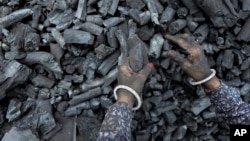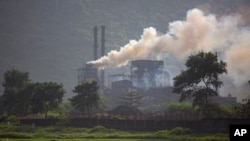India is rapidly ramping up green energy projects in its bid to reduce carbon emissions but the dependence on coal to power its fast-growing economy also increased this year.
In the western Gujarat state, Modhera became India's first village to be powered completely by solar energy in October. The $10 million project involved setting up rooftop panels on residential and government buildings, giving hundreds of low income residents access to affordable power.
In Rajasthan state in the country's northwest, 10 million gleaming solar panels sprawl over a 5,700-hectare desert site. The construction of the Badhla solar park, now the world's largest, has been done in stages since 2015 and it now generates enough electricity to power over 1 million homes.
As billions of dollars are invested in both large and small projects of this kind, India hopes to expand its renewable energy sector into one of the world's largest. Experts, though, say they may not be enough to help meet the country's goal of generating half its energy through nonfossil fuels by 2030.
"While we are on the right direction, we are, on an annual basis, adding more and more nonfossil fuel capacity, but it's still falling short of the 30 gigawatt of annual capacity addition that is required," Vibhuti Garg, director for South Asia at the Institute for Energy Economics and Financial Analysis, a U.S. energy analysis organization, said.
"So definitely there is space to do much more than what we are doing currently," she said.
Even as green energy gets a boost, India also increased coal production this year to meet the galloping demand of an economy that has rebounded after the pandemic. This summer, as a searing heat wave led to power outages, the government gave coal mines the green light to boost production. Last month, it announced that it would auction about 140 new coal mines to the private sector.
Officials have said there will be no transition away from coal in the foreseeable future as demand for coal had not yet peaked in the country. In November, Coal and Mines Minister Pralhad Joshi told a parliamentary panel that, "For India, coal, being an affordable source of energy, holds prime importance for meeting its energy needs being fueled by rising economy."
The reason is that India's energy needs are expected to grow more than anywhere in the world over the next two decades – the country is growing at the fastest pace among major economies propelling more and more of its 1.4 billion people into the middle class.
Climate campaigners agree that India faces a dilemma in balancing its goals for development with its pledges to reach net zero emissions by 2070. Coal accounts for about 70% of India's power generation.
"We need to look at how as the economy is bouncing back, demand for power has been growing," according to Harjeet Singh, head of global political strategy at Climate Action Network International, which backs action to fight climate change.
"We have also seen that this year's incidence of heat wave added to the demand for more electricity because people started using air coolers and air conditioners much more. And for India to develop and provide more jobs, there is a pressure to increase coal," he said.
As in several other countries, the disruption in world energy markets this year also made it harder for India to wean itself off coal.
"Because of the Russia-Ukraine war or because of the COVID-19 pandemic, from the energy security perspective, all countries including India have started looking inwards and are starting to exploiting more and more of their domestic resources," according to Garg. "And India is endowed with domestic coal, so definitely in the last few months, there has been an increasing emphasis on use of coal."
Experts like Garg however are optimistic that older plants that emit more greenhouse gas will be phased out and replaced by more efficient ones based on newer technology thus making it possible to hold down carbon emissions.
India is the world's second-largest coal producer behind China, according to the International Energy Agency.
At the recent climate summit in Egypt, India, the world's third-largest emitter of greenhouse gases, said it is committed to pursuing low-carbon strategies for development. But it also pushed for more finance and technology from developed countries to enable the transition.
Experts point out that funding the country's switch to green energy is expensive and failure to meet commitments made by rich countries of providing $100 billion a year to developing ones is a setback.
"The cost has to come down if we need to reduce our reliance on fossil fuels. Without adequate support from the international community on finance, it is going to be extremely difficult because then, practically speaking, India is on its own to make that transition," Singh said.
Experts say because of its size, the pace at which India eliminates coal from its energy mix will be of paramount importance in limiting global warming to 1.5 degrees Celsius to tackle global climate change.











